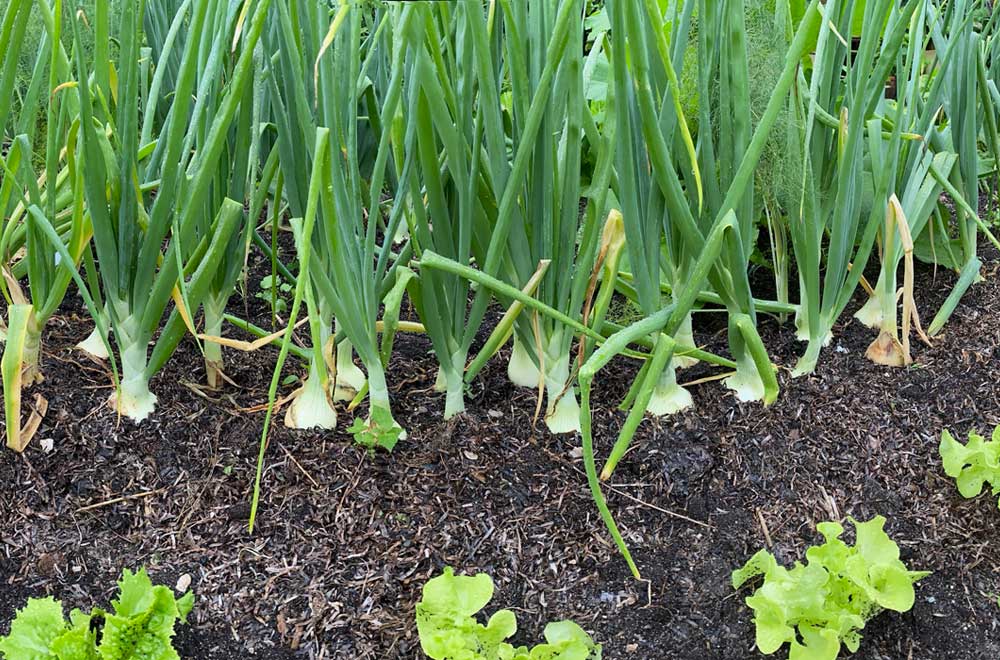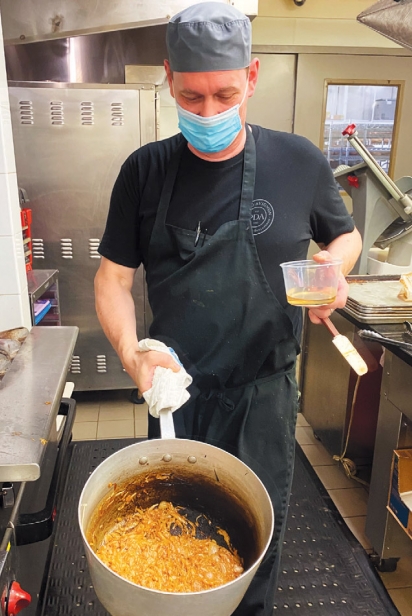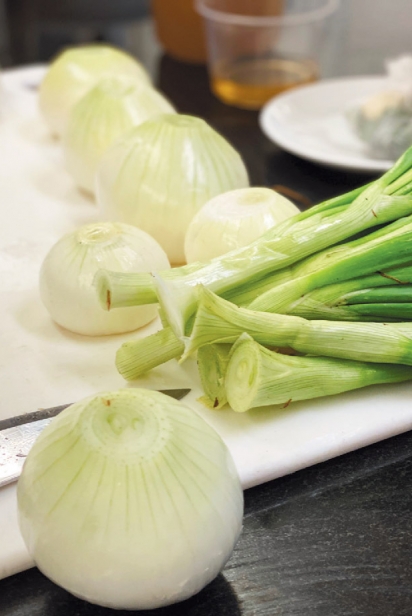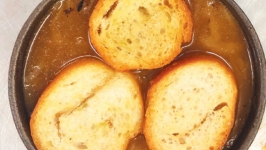Stinking Alliums
These recent times of uncertainty have made some of us reflect on the lives and hardships of our ancestors and on the importance of self-reliance. It was only a few generations ago when families, local market gardeners and backyard farmers fed their communities year-round. Many crops were grown specifically to be stored in root cellars or canned to last through the winter and unexpected hardships; something that is newly familiar to us.
In days 150 years ago of local market growing and community sustainability, even the smallest open ground, wedged between city streets, apartments or down a country lane, were used to grow crops. I love the extensive books that were written by horticulturists on the subject of individual vegetables and fruits. Whole books were dedicated to only celery or asparagus, broccoli or beets, just about every fruit or vegetable in existence. They were written with a flair and a passion that could excite even the armchair farmer to get up and go try it for themselves, covering every stage of a vegetable’s growth and giving each one monumental importance. They were “vegetable novelists.” They gave many a lowly vegetable, some with very shady pasts but once cherished by ancient societies, grand reintroductions into society.
Vegetables such as the “stinking alliums,” a family of vegetables we need to revisit and recognize as an essential crop in our home gardens and on our menus during a time when growing and storing our own food has a new significance. The most widely recognized and cultivated species of Allium in this genus of over 800 species is Allium cepa, the bulb onion, a vegetable generally regarded with little fanfare.
Many societies throughout history have had an aversion to the “bulb onion” on account of its offensive odor and long-standing social and religious taboos through the centuries.
While the place and time of the onion’s origin are still a mystery, their use is believed to have begun long before farming or writing was even invented. Pictured in ancient Egyptian tombs and referenced in many documents since very early times, their cultivation by humans has been confirmed as early as 5000 years ago. In Egypt onions fed the builders of the pyramids and royalty alike, but they became more than just food: the ancient Egyptians worshipped the onion, believing that its spherical shape and concentric rings symbolized eternity. They used onions in the process of embalming Kings, and in fact, traces of onions were found in Ramesses IV’s eye sockets. Of all the vegetables that had their images made from precious metals by Egyptian artists, only the onion was made out of gold!
It wasn’t until the onion made its way into Roman society that we have written records of its culinary and medicinal use. Pliny the Elder, before he was silenced by Mount Vesuvius and the destruction of Pompeii, would often mention onions in his writings. He catalogued the Roman beliefs about the ability of the onion to cure vision problems, induce sleep, heal mouth sores, dog bites, toothaches, dysentery and lumbago. Excavators of the doomed city would later find gardens where, just as Pliny had said, onions had grown. The bulbs had left behind telltale hollows in the ground.
Onions appeared to be a gourmet favorite of the Romans. The infamous Roman cookbook Apicius, otherwise known as De re Coquinaria (On the Subject of Cooking) and believed to have been written in the first century A.D., included many recipes for the onion. Onion soup was one of them, as attests this Apicius recipe:
“Serve onions with oil broth and vinegar sprinkled with cumin,” or “Cook the bulbs into a thick puree and season with thyme, origany, honey, vinegar, reduced wine or date wine, broth and a little oil.”
It was the Romans who introduced the onion family to Europe, and centuries later the modern version of onion soup appeared in Paris during the 18th century. It was made from beef broth and caramelized onions, but this time “au gratinée” (topped with grated and browned cheese). Perhaps the grandest stature that the onion has ever attained was in this acclaimed French culinary rendition of onion soup. On researching the actual birthplace of the beloved French onion soup, I conclude that I have never encountered a recipe with as many stories about who invented it as French onion soup.
Throughout history onions were seen as food for both poor and elite, as onions were plentiful and easy to grow. At Les Halles open market in Paris, referred to by Emile Zola as the “belly of Paris,” people from all walks of life bought and sold foods of all manner. Opened in 1135 and spreading over 25 acres, many of Paris’ poorest residents were drawn to this “immense pantry.” The poorest of the poor ate “arlequins,” plates of leftovers sold by servants from the grand banquets of their employers, and which got their name from the multicolored appearance of the soup-to- nuts plates, like “harlequins,” containing everything from appetizers to desserts. A little more expensive but just as filling, one could choose a steaming hot onion soup from an immense cast iron kettle hanging from a tripod at every corner of the market. It was a breakfast favorite of the rich recovering from the debauchery of the night before, as well as the poor and the working class on their way to a long day of toil. A vendor would drop a few thin slices of stale bread into the bottom of a cup and ladle in a spoonful of a thin, steaming liquid.
This watery broth rose in status with the extravagant addition of a fine cheese. This was the birth of classic French onion soup as we know it! Since onion soup has been in France’s culinary history for so long it’s nearly impossible to know who first invented it for sure, but there are plenty of stories. Whoever it was, it is much agreed that it came from the restaurants surrounding legendary Les Halles open market.
Onion Cultivation
Growing onions for winter storage and having them on hand for French onion soup is not only easy but a valuable addition to your pantry, and there are few crops that are better adapted to our northern climate. Onions grow best in relatively cool weather and require abundant moisture during their early stages of green growth, and a period of dry weather for the bulbs to mature properly, making our cool, wet spring and dry late summers the perfect environment. Onions are photoperiodic, meaning they regulate their stages of growth by day length. They make top growth until the critical light duration is reached, then bulbing begins. Different varieties require different day lengths to mature properly. Here in the north we require “long day” types, where early summer day length is between 14-16 hours. Short-day varieties do well in southern states and bulb when day length is 10-12 hours. Day-neutral varieties start bulbing when day length is 12-14 hours and can be successfully grown anywhere.
To grow a good onion, as instructed by the “vegetable novelists” of old, special attention should be given to the young transplants. They also insist that the best onions are grown from seed, not onion sets. The soil should be well drained and “quick” (well fertilized and with adequate moisture supplied when young). Since onions are mainly surface feeders, a preparation of well-rotted manure or aged compost worked into the soil and amended with a surface dressing of good fertilizer and wood ash lightly worked in is good. Weeding is absolutely essential for good development, particularly when the plants are young. The green growth period results in the ultimate size and quality of your onions. Each tube of green coincides with one of many layers within the onion bulb. The phrase “layers of the onion” actually refers to the underground scales that to form layer upon layer and expand an onion into its bulb shape. The hollow, cylindrical, flattened fan-shaped swathes of green top growth above ground are individually connected to each layer, making it that much more important to tend well to young onions and to plant early.
Onions can be grown on the same land year after year with good results by freely fertilizing unless disease or pests force a rotation. Planting onions where a previously well-manured and dug crop was sown will also produce great results. Onions are heavy feeders and surprisingly use a much greater quantity of fertilizer than most crops and should be side dressed throughout their growing season with potash and phosphoric acid.
There are quite a few interesting varieties of onions (some even hardy perennials in the north), varieties long forgotten and replaced by modern commercial types. They were once very popular varieties that our ancestors planted, like “Potato Onions.” Hardy and productive, potato onions are classified as “multiplier” onions which exist in two horticultural forms, the potato onions and shallots. Both need to be planted by bulb and not seed. It is claimed that potato onions can produce a larger yield per area than any other vegetable except staked tomatoes. These unusual onions produce a cluster of bulbs at ground level from a single planted bulb. The larger bulbs are saved for eating, and the medium and small bulbs are stored and replanted. Both potato onions and shallots can be grown in pots for forcing green onions during the winter, too. There are many advantages of growing multiplier onions. Their resistance to pests and disease is advantageous, but even more valuable is that once you have enough potato onions or shallots, you need not buy seeds or sets again. Potato onions and shallots store well, and can withstand subfreezing temperatures. Like garlic, potato onions and French shallots are planted in the fall 4-6 weeks before the ground freezes.
Onions are ready to harvest in approximately 100 days or when the green tops begin to dry and fall over. On sunny, breezy days, onions can be allowed to cure in the field for a day or two before being taken to a shady, well-ventilated area to cure. The bulbs are cured when you can pull the dried tops off easily. Remove only dirty wrapper leaves or any that may be falling off, as onion skins contain enzymes that increase storage and maintain quality. Store the bulbs in a cold place (38 to 45 degrees), out of direct light. Curing must take place for the onions to be stored for any length of time. With warm temperatures, good air circulation and low humidity, curing should be complete in a few weeks.
At Pain D’Avignon in Hyannis, Chef Christophe Gest makes a traditional French onion soup topped with Gruyère. The soup is offered year-round, although it is not available at dinner during summer. Pain D’Avignon sources locally for as many of their ingredients as possible and make more than a special effort to do so. On this day, for this recipe, they used Walla Walla sweet onions from Tuckernuck Farm. Chef Christophe, while making the soup for this article, reminisced of his childhood in France and how his family followed the French tradition of making onion soup every New Year’s Eve. After midnight celebrations come to an end, the making of the soup commences and families around France partake in a New Year’s Day breakfast of French onion soup. It’s a tradition reaching back to the days of Les Halles.









